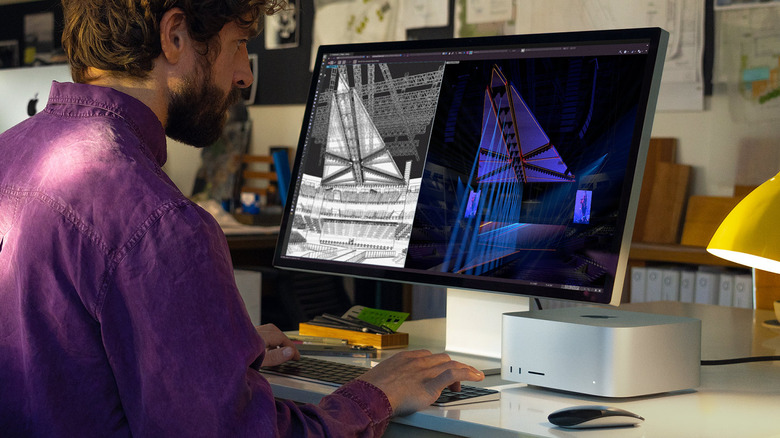After Slamming The iMac 27" With Mac Studio Praise, Apple Just Axed It
It's officially the end of the road for the 27-inch iMac. Apple has removed the model from the lineup on its website, meaning you'll need to find a used unit or pick up the 2021 M1 iMac (which has a smaller 24-inch display) if you're looking for an all-in-one Apple desktop computer. Of course, the company also has some other alternatives, namely its newly introduced and soon-to-be-released Mac Studio.
Apple's decision to pull the 27-inch iMac from the lineup isn't terribly surprising, as the company used this model for its Mac Studio performance comparison charts. When it comes to GPU performance, for example, Apple said the new Mac Studio featuring the M1 Ultra chip is 4.5 times faster than the 27-inch iMac packing the Radeon Pro 5700XT. In case you were wondering, we also have details about how the M1 iMac compares to the newly unveiled Mac Studio, too.
iMac is no match for the Mac Studio
If you're looking for a Mac with the best performance Apple has to offer, its new Mac Studio is the device you want — though, be warned, it doesn't come cheap with a starting price of $3,999 for the M1 Ultra version or $1,999 for the M1 Max version. If you happen to already own a 27-inch iMac and you're thinking about upgrading — or perhaps you're debating about picking up a refurbished model — Apple has some details you'll probably want to consider.
The Mac Studio with the M1 Ultra chip is, Apple said during its spring event, substantially more powerful than the aging iMac. The CPU performance is 3.8x faster compared to the 10-core 27-inch iMac with an i9 processor, for example. Customers who don't want to drop at least a few grand on a desktop will still get better performance with the M1 Max version of the Mac Studio, mind, with Apple reporting 2.5 times better CPU performance over the 27-inch iMac.
Beyond that, Apple went on to say that the M1 Max will get buyers 3.4 times faster speeds compared to the fastest iMac model, which would refer to last year's M1 iMac. That all-in-one desktop sports the base M1 chip packing an 8-core CPU and (up to) an 8-core GPU. Compare that with the M1 Max's 10-core CPU and 32-core GPU, which itself eclipses the M1 Pro chip previously announced alongside its Max sibling. If you're more worried about price than maxing out performance, however, it's worth noting the M1 iMac starts at $1,299, though that only gets you the 7-core GPU option. If you want the full 8-core CPU/GPU M1 chip, you'll need to spend at least $1,499.

